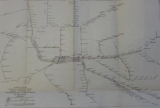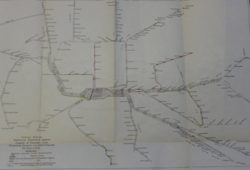
Ashworth Improvement Plan
Encyclopedia
The Ashworth Improvement Plan was a report that recommended a number of improvements to be made to the electrified suburban railways
of inner city Melbourne
, Australia
. It was produced in 1940 by a committee headed by John Marmaduke Ashworth, the Victorian Railways
Chief Engineer for Way and Works. In order to meet projected future needs, the report recommended duplication of lines, terminal improvements and underground railway connections.
of the suburban railways begun in 1919, and patronage grown by 63.4% over just six years, from 96,797,783 in 1917-18 to 158,194,558 in 1923-24.
What was not apparent to the public was that the electrification project had not been accompanied by any other works, cutting costs by putting limitations on growth.
By 1937-38 patronage had grown to 135,329,598 but the pattern of suburban rail travel was changing. People were living further from the inner city, and the average distance travelled by commuters changed from 9.0 km in the early 1930s to 10.4 km by the end of the decade. The Victorian Railways Commissioners established a committee in 1938 to study the impact of the increase of long distance suburban traffic. It consisted of three officers headed by Ashworth.
At the time the report was commissioned, Melbourne consisted of 173 route miles of railways (owned by the Government of Victoria), 140 route miles of tramways (vested in the Melbourne and Metropolitan Tramways Board) and 57 route miles of bus routes, whilst private individuals or companies operated approximately 350 bus route miles over 105 routes.
 The report was released in 1940. The Commissioners wrote that the report covered works that would provided transport facilities for years to come, but at a cost of several million pounds. The works would need to be spread over several years, not just for funding reasons, but to avoid disruption of existing services.
The report was released in 1940. The Commissioners wrote that the report covered works that would provided transport facilities for years to come, but at a cost of several million pounds. The works would need to be spread over several years, not just for funding reasons, but to avoid disruption of existing services.
Recommendations included:
The report also recommended that there was an urgent need for effective co-ordination of all transport facilities to reduce the anomalies with wasteful competition in some localities.
. It was completed in August 1943. In 1944 work began on a new bridge at South Yarra, being completed in 1947 with only four tracks, with the provision for two more to be added later.
The rest of the works were not carried out, but some were revisited later. Much of the track amplification was carried out as part of the 1950s Operation Phoenix
and a variant of the City Railway was built as the City Loop that started in 1970 and was completed in 1985.
Railways in Melbourne
The Melbourne rail network is operated by Metro Trains Melbourne under franchise from the Government of Victoria. The network is based on a commuter rail model centred on the Melbourne Central Business District and Flinders Street Station, rather than a rapid transit model, with a focus on...
of inner city Melbourne
Melbourne
Melbourne is the capital and most populous city in the state of Victoria, and the second most populous city in Australia. The Melbourne City Centre is the hub of the greater metropolitan area and the Census statistical division—of which "Melbourne" is the common name. As of June 2009, the greater...
, Australia
Australia
Australia , officially the Commonwealth of Australia, is a country in the Southern Hemisphere comprising the mainland of the Australian continent, the island of Tasmania, and numerous smaller islands in the Indian and Pacific Oceans. It is the world's sixth-largest country by total area...
. It was produced in 1940 by a committee headed by John Marmaduke Ashworth, the Victorian Railways
Victorian Railways
The Victorian Railways operated railways in the Australian state of Victoria from 1859 to 1983. The first railways in Victoria were private companies, but when these companies failed or defaulted, the Victorian Railways was established to take over their operations...
Chief Engineer for Way and Works. In order to meet projected future needs, the report recommended duplication of lines, terminal improvements and underground railway connections.
Background
Melbourne had been a city dominated early on by suburban railways, with the system reaching its peak early in 1891 on the back of a number of speculative lines. In the early twentieth century, Melbourne easily had the best public transport in Australia. In 1907 both trams and trains carried about 62 million passengers per year. Electric operationRailway electrification system
A railway electrification system supplies electrical energy to railway locomotives and multiple units as well as trams so that they can operate without having an on-board prime mover. There are several different electrification systems in use throughout the world...
of the suburban railways begun in 1919, and patronage grown by 63.4% over just six years, from 96,797,783 in 1917-18 to 158,194,558 in 1923-24.
What was not apparent to the public was that the electrification project had not been accompanied by any other works, cutting costs by putting limitations on growth.
By 1937-38 patronage had grown to 135,329,598 but the pattern of suburban rail travel was changing. People were living further from the inner city, and the average distance travelled by commuters changed from 9.0 km in the early 1930s to 10.4 km by the end of the decade. The Victorian Railways Commissioners established a committee in 1938 to study the impact of the increase of long distance suburban traffic. It consisted of three officers headed by Ashworth.
At the time the report was commissioned, Melbourne consisted of 173 route miles of railways (owned by the Government of Victoria), 140 route miles of tramways (vested in the Melbourne and Metropolitan Tramways Board) and 57 route miles of bus routes, whilst private individuals or companies operated approximately 350 bus route miles over 105 routes.
The report

Recommendations included:
- additional platforms at the Flinders StreetFlinders Street StationFlinders Street Station is the central railway station of the suburban railway network of Melbourne, Victoria, Australia. It is on the corner of Flinders and Swanston Streets next to the Yarra River in the heart of the city, stretching from Swanston Street to Queen Street and covering two city...
/Princes Bridge station complex, involving tracks on two levels and a connection to an underground City Railway to distribute passengers closer to their places of work. - extensive roofing over of Jolimont YardJolimont YardJolimont Yard was an array of railway lines and carriage sidings on the edge of the central business district of Melbourne, Australia. Located between Flinders Street Station, Richmond Junction, the Yarra River and Flinders Street they were often criticised for cutting off the city from the river,...
, permitting rental income to fund the program. - track duplication on the single track Glen Iris, Ashburton and Heidelberg lines.
- track duplication from Flinders Street to South Yarra, including a new Cremorne Bridge over the Yarra RiverYarra RiverThe Yarra River, originally Birrarung, is a river in east-central Victoria, Australia. The lower stretches of the river is where the city of Melbourne was established in 1835 and today Greater Melbourne dominates and influences the landscape of its lower reaches...
. - track duplication from Flinders Street to Hawthorn.
- rebuild Richmond railway stationRichmond railway station, MelbourneRichmond is a railway station in Melbourne, Victoria, Australia, located in the suburb of Richmond. It is classed as a Premium Station and is in Metcard Zone 1.-Facilities:...
.
The report also recommended that there was an urgent need for effective co-ordination of all transport facilities to reduce the anomalies with wasteful competition in some localities.
Actions
Very few of the recommendations were able to be carried out immediately due to the ongoing war effort. Only one of the elements was able to be completed during this period - the flyover at Burnley station that permitted down Glen Waverley line trains to cross those headed towards HawthornHawthorn railway station, Melbourne
Hawthorn is a railway station in Melbourne, Victoria, Australia. It is located on the Lilydale, Belgrave, and Alamein lines, at Burwood and Evansdale Roads in the suburb of Hawthorn...
. It was completed in August 1943. In 1944 work began on a new bridge at South Yarra, being completed in 1947 with only four tracks, with the provision for two more to be added later.
The rest of the works were not carried out, but some were revisited later. Much of the track amplification was carried out as part of the 1950s Operation Phoenix
Operation Phoenix (railway)
Operation Phoenix was a post World War II rehabilitation program carried out by the Victorian Railways in Australia. The program commenced in 1950 and was originally planned to take 10 years and cost £80 million pounds...
and a variant of the City Railway was built as the City Loop that started in 1970 and was completed in 1985.
See also
- Railways in MelbourneRailways in MelbourneThe Melbourne rail network is operated by Metro Trains Melbourne under franchise from the Government of Victoria. The network is based on a commuter rail model centred on the Melbourne Central Business District and Flinders Street Station, rather than a rapid transit model, with a focus on...
- Operation PhoenixOperation Phoenix (railway)Operation Phoenix was a post World War II rehabilitation program carried out by the Victorian Railways in Australia. The program commenced in 1950 and was originally planned to take 10 years and cost £80 million pounds...
- 1969 Melbourne Transportation Plan1969 Melbourne Transportation PlanThe 1969 Melbourne Transportation Plan was a road and rail transport plan for Melbourne, the state capital of Victoria, Australia instituted by Henry Bolte's state government...
- Lonie ReportLonie ReportThe Lonie Report, officially titled Victorian Transport Study, was a thoroughgoing study of freight and passenger transport within the state of Victoria, in Australia...
- New DealNew Deal (railway)The New Deal' for Country Passengers was a timetable introduced on 4 October 1981 in Victoria, Australia that revolutionised the provision of country passenger railway services. 35 little-used passenger stations were closed, rolling stock utilisation improved, and new rolling stock introduced...
- Regional Fast Rail projectRegional Fast Rail projectThe Regional Fast Rail project was a rail transport project of the State Government of Victoria, Australia undertaken between 2000 and 2006 aimed at improving the passenger services on the Victorian regional railway network , specifically to reduce travel times, enhance service frequency and...
- List of proposed Melbourne rail extensions

